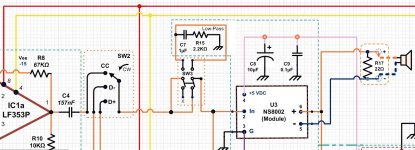Because in a previous stage of the circuit I am trying to eliminate what is common to both the left and right channels of a stereo input - typically voice - I have to consider that I have dropped off some bass. So I figured I would (optionally) include a low-pass filter in hopes of increasing the presence of the ~70Hz range.
Am I fooling myself?
Am I fooling myself?
Attachments
To enhance the information around a particular frequency (without affecting anything else), you'd need to use a graphic / parametric equaliser of the appropriate Q-factor and gain at the required frequency.
https://sound-au.com/project28.htm
A 70Hz lowpass filter would remove anything above 70Hz..
https://sound-au.com/project28.htm
A 70Hz lowpass filter would remove anything above 70Hz..
I'm not sure this will be understandable without diagram, but the usual approach is:
A. Subtract left and right
B. Average or add left and right and low-pass filter the result
C. Add the low-pass filtered sum signal to the difference signal, with an adjustable gain for the filtered sum
A. Subtract left and right
B. Average or add left and right and low-pass filter the result
C. Add the low-pass filtered sum signal to the difference signal, with an adjustable gain for the filtered sum
thank you
entirely? would there not just be a gradual dropoff?To enhance the information around a particular frequency (without affecting anything else), you'd need to use a graphic / parametric equaliser of the appropriate Q-factor and gain at the required frequency.
https://sound-au.com/project28.htm
A 70Hz lowpass filter would remove anything above 70Hz..
The section marked low pass reaches around 3kohms just above 12kHz, where it levels out. Could you bring this down to make it a shelving filter?
I wouldn't know how.
I have, however, rethought the cutoff frequency and lowered the 2.2K to 680 ohms yielding a frequency of around 234 Hz which suits me.
But as for a shelving filter please tell me how.
I have, however, rethought the cutoff frequency and lowered the 2.2K to 680 ohms yielding a frequency of around 234 Hz which suits me.
But as for a shelving filter please tell me how.
The impedance of that section will fall with frequency until it approaches the value of resistance, where it bottoms out, stopping the low pass rolloff.
I'm not going to speculate on numbers as I don't know the circuit or details about the surrounding stages.
I'm not going to speculate on numbers as I don't know the circuit or details about the surrounding stages.
That's troublesome unless there's a delay / phase adjustment before the addition, as the low freq from L & R channels would not make it (equally well) into the final output.I'm not sure this will be understandable without diagram, but the usual approach is:
A. Subtract left and right
B. Average or add left and right and low-pass filter the result
C. Add the low-pass filtered sum signal to the difference signal, with an adjustable gain for the filtered sum
But as for a shelving filter please tell me how..
http://shiwasu.ee.ous.ac.jp/matweb_cs/help/english_lagcompensator.htm
Last edited:
thank youThe impedance of that section will fall with frequency until it approaches the value of resistance, where it bottoms out, stopping the low pass rolloff.
I'm not going to speculate on numbers as I don't know the circuit or details about the surrounding stages.
That's troublesome unless there's a delay / phase adjustment before the addition, as the low freq from L & R channels would not make it (equally well) into the final output.
Is it? Averaging left and right to get a mono signal has been done since the introduction of stereo. It's also quite common for stereo with two satellite speakers and a common subwoofer.
No, not like that, the filtered L+R is a nice mono sound with bass information below 70Hz intact. However, wouldn't summing it into the L-R signal strengthen the L channel bass and weaken that from R channel ?
L+R (bass) + L-R (normal) => L (extra bass) + R (no bass)
L+R (bass) + L-R (normal) => L (extra bass) + R (no bass)
Of course, good point! If you would process a recording with bass-producing instruments on the left, middle and right, the one on the left would be too strong and the one on the right too weak when you set the gain for the sum signal such that the middle is about right.
Karaoke circuits like this are typically used on pop music recordings that have both the voice and the bass mixed in the middle. It works reasonably well on those.
You could reduce the issue a bit by high-pass filtering the difference signal. You can then only get cancellation effects around the crossover frequency with bass that is not in the middle.
Karaoke circuits like this are typically used on pop music recordings that have both the voice and the bass mixed in the middle. It works reasonably well on those.
You could reduce the issue a bit by high-pass filtering the difference signal. You can then only get cancellation effects around the crossover frequency with bass that is not in the middle.
I never expected the discussion to reach as far as it has or i'd have included the entire circuit which I now have.
Yes, if the bass was not recorded centrally like the voice usually is it'd be unbalanced.
But when SW2 is in "D-" mode R7 (2-gang balance) would allow the user to focus in on that lower range.
Yes, if the bass was not recorded centrally like the voice usually is it'd be unbalanced.
But when SW2 is in "D-" mode R7 (2-gang balance) would allow the user to focus in on that lower range.
Attachments
- Home
- Design & Build
- Electronic Design
- Question About Low-Pass
